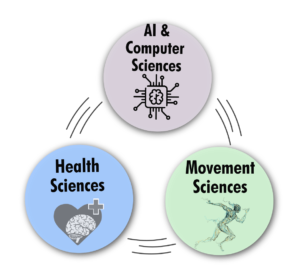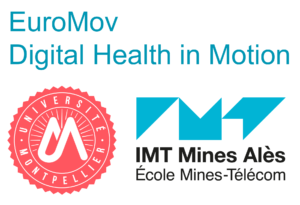Euromov
Euromov Digital Health In Motion
Research areas: Informatics, Clinical Research, Science and Technology of Physical and Sports Activities
Director: Prof. Stéphane Perrey (University of Montpellier)
Co-director: Prof. Jacky Montmain (IMT Mines Alès)
TheEuroMov Digital Health in Motion joint research unit (under the auspices of the University of Montpellier and IMT Mines Alès) aims to promote the cross-fertilization of artificial intelligence, movement sciences and health sciences to understand human behavioral plasticity, with a view to improving sensory-motor performance and developing new therapeutic approaches, and to use it as a scientific metaphor to inspire new digital approaches: machine learning or adaptive control of complex systems, human/machine interaction and context-sensitive software systems. Ultimately, this line of research on "Digital Health in Movement" aims to better understand the etiology of human movement, considered as the level of integration of biological and cognitive phenomena, in the course of our ongoing informational exchanges with the environment.
The research unit employs around 100 people: 43 teacher-researchers including 39 permanent staff, 12 associate staff (fixed-term contracts, permanent CHU staff), 9 research support staff including 4 IR, 1 IE and 3 BIATS, around 30 PhD students and Master's students (research internships or engineering students).
The research unit is located on several sites: EuroMov building (Campus Veyrassi UFR STAPS de Montpellier), which also hosts startups and several experimental and technological platforms, building on the Louis Leprince Ringuet technology campus (IMT Mines Alès) and premises dedicated to movement analysis for patients at the university hospitals of Nîmes (with the Grau du Roi site) and Montpellier and at the Beausoleil clinic (movement and sleep).
several experimental and technological platforms, building on the Louis Leprince Ringuet technology campus (IMT Mines Alès) and premises dedicated to movement analysis for patients at the university hospitals of Nîmes (with the Grau du Roi site) and Montpellier and at the Beausoleil clinic (movement and sleep).
The unit is organized into three scientific themes and two transverse axes:
- Perception In Action & Synchronization(PIAS) theme: discover the laws governing human perception in moving agents (perception in action) and human-environment synchronization in general.
- Monitoring and Improving Behaviors(MIB) theme: providing users with advice on how to improve their behaviors to achieve better health, quality of life or sporting performance, with a particular focus on software engineering.
- Learning and Complexity Theme(LAC): focuses on the study of human learning and complexity through the signatures of health movement, clinical data and neural activity indicators, notably by developing interpretable models.
- Semantics and Taxonomy of Movement(SemTaxM): identify taxonomic classifications of movement and define a theory of semantics supported by movement and models of semantics anchored in specific contexts.
- Transversal axisFactoryaimsto improve the reproducibility of results and accelerate translational research and technology transfer by providing standardized, documented approaches with an open data dissemination strategy.
Supervision: University of Montpellier, IMT Mines Alès
Healthcare partners : CHU Montpellier, CHU Nîmes, Clinique Beausoleil and Korian Group (R&D).
Scientific clusters Biology and Health (BS); Mathematics, Informatics, Physics and Systems (MIPS)
Doctoral schools : Human Movement Sciences (SMH); Information, Structures and Systems (I2S)
Research areas:Biomechanics, Computer Science, Neuroscience, Physiology, Psychology, Neuroergonomics, Physical Medicine and Rehabilitation.Keywords:brain activity, physical activity, analysis, decision support, learning, cognition, data, fatigue, software engineering, image, interdisciplinarity, human-computer interface, internet of things, artificial intelligence, modeling, movement, digital, optimization, chronic pathologies, perception, performance, plasticity, rhythms, health, sleep, sport, taxonomy, technologies, translational, computer vision.


